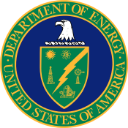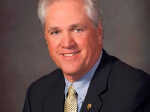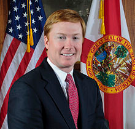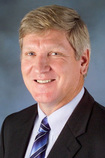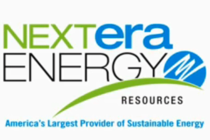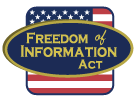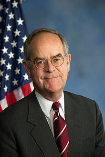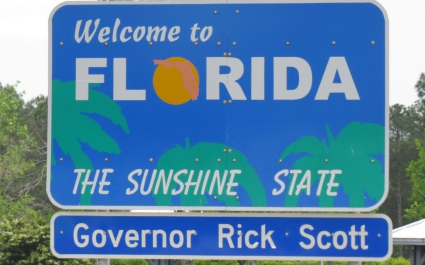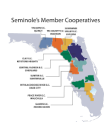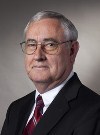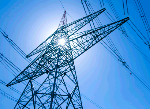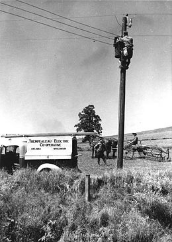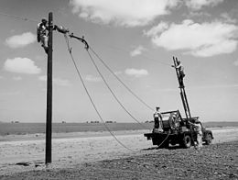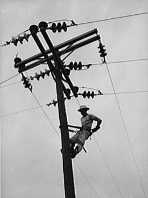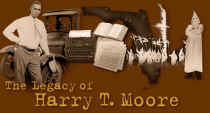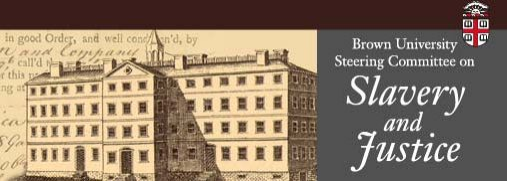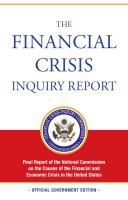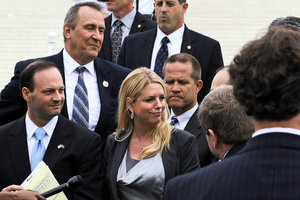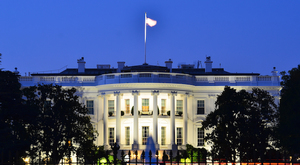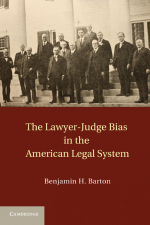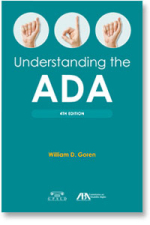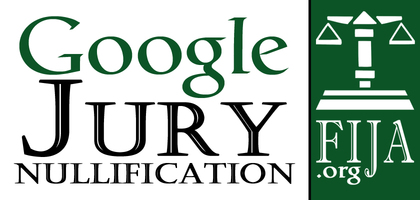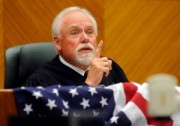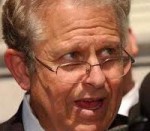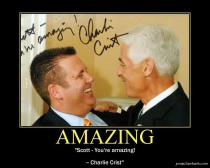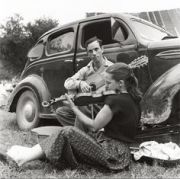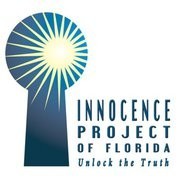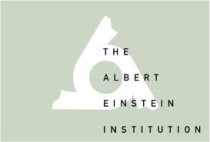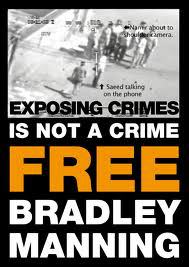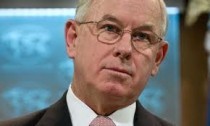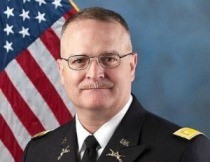Solar energy
Wikipedia
Solar energy is radiant light and heat from the Sun that is harnessed using a range of ever-evolving technologies such as solar heating, photovoltaics, solar thermal energy, solar architecture and artificial photosynthesis.[1][2]
It is an important source of renewable energy and its technologies are broadly characterized as either passive solar or active solar depending on how they capture and distribute solar energy or convert it into solar power...
...The total solar energy absorbed by Earth's atmosphere, oceans and land masses is approximately 3,850,000 exajoules (EJ) per year.[10] In 2002, this was more energy in one hour than the world used in one year...Read more
US Department of Energy
1000 Independence Ave. SW
Washington DC 20585
Tel. 202-586-5000
Dr. Grace Bochenek
Secretary of Energy (Acting)
Dr. Grace Bochenek is an American industrial engineer who is the current Director of the National Energy Technology Laboratory within the United States Department of Energy's Office of Fossil Energy. She is also the current acting United States Secretary of Energy. She previously had spent much of her career at the U.S. Army Tank Automotive Research, Development and Engineering Center. Wikipedia
U.S. EPA Fact Sheets - Clean Power Plan
____________________________________________________
United States Department of Energy
Wikipedia
The United States Department of Energy (DOE) is a Cabinet-level department of the United States Government concerned with the United States' policies regarding energy and safety in handling nuclear material. Its responsibilities include the nation's nuclear weapons program, nuclear reactor production for the United States Navy, energy conservation, energy-related research, radioactive waste disposal, and domestic energy production. It also directs research in genomics; the Human Genome Project originated in a DOE initiative.[2] DOE sponsors more research in the physical sciences than any other U.S. federal agency, the majority of which is conducted through its system of National Laboratories.[3]
The agency is administered by the United States Secretary of Energy, and its headquarters are located in Southwest Washington, D.C., on Independence Avenue in the James V. Forrestal Building, named for James Forrestal, as well as in Germantown, Maryland.
Read more U.S. EPA Fact Sheets - Clean Power Plan
____________________________________________________
Sumter Electric Cooperative, Inc., d.b.a. SECO Energy
Sumter Electric Cooperative, Inc., d.b.a. SECO Energy, is a Rural Electric Cooperative, governed by Chapter 425, Florida Statutes.
SECO Energy Chief Executive Officer Jim Duncan and Senior Staff
SECO Energy Board of Trustees
SECO Energy celebrated its 78th Annual Meeting of the Membership on Saturday March 19th, with over 3,000 SECO Energy members and guests.
SECO Energy is an Electric DISTRIBUTION COOP currently serving homes, business and farms in seven counties.
Seminole Electric Cooperative, Inc. is an Electric GENERATION and TRANSMISSION COOP owned by 9 Florida Electric Distribution COOPs, including Sumter Electric Cooperative, Inc. "SECO Energy".
SECO Board Policy 207 Terms and Conditions of Service
___________________________________________________
PUBLIC RECORDS PROVIDED BY THE USDA-RUS UNDER FOIA
_____________________________________
US Department of Agriculture (USDA), Rural Electric Service (RUS)
Financial and Operating Report for Electric Distribution 2013-2015 for Sumter Electric Cooperative, Inc., d.b.a. SECO Energy
USDA RUS loan list - Sumter Electric Cooperative, Inc. 2010-2014
Sumter Electric Cooperative, Inc. Corporate Bylaws SECO Energy, Revised March 29, 2003
____________________________________________________
Jim Duncan - Sumter Electric Co-op's Million Dollar Man
SECO'S MILLION DOLLAR MAN
James P. Duncan was paid $1,058,630 as CEO of Sumter Electric Cooperative, Inc., d.b.a. SECO Energy, according to the 2014 IRS Form 990 Return of Tax Exempt Organization for Sumter Electric Cooperative, Inc., see page 7, Part VII, Compensation of Officers, Trustees, Key Employees, Highest Compensated Employees, and Independent Contractors: $968,494 in reportable compensation for 2014, plus $90,136 in other compensation.
Foundation Center-Find Funders-990 Finder (IRS 990 Form)
http://foundationcenter.org/findfunders/990finder/
Sumter Electric Cooperative, Inc.
The US federal government and the State of Florida are encouraging home owners to help supply our future electricity demand.
Solar Photovoltaic Information for Sumter Electric Members
Customer-owned Renewable Generation Systems (RGS) Checklist
Interconnection Agreement for Customer-owned Renewable Generation Systems for 1,000 kW or Less
____________________________________________________
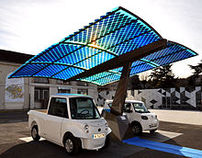 Photovoltaic SUDI shade is an autonomous and mobile station in France that provides energy for electric vehicles using solar energy.
Photovoltaic SUDI shade is an autonomous and mobile station in France that provides energy for electric vehicles using solar energy.
Photovoltaics
Wikipedia
Photovoltaics (PV) is the name of a method of converting solar energy into direct current electricity using semiconducting materials that exhibit the photovoltaic effect, a phenomenon commonly studied in physics, photochemistry and electrochemistry. A photovoltaic system employs solar panels composed of a number of solar cells to supply usable solar power. The process is both physical and chemical in nature, as the first step involves the photoelectric effect from which a second electrochemical process takes place involving crystallized atoms being ionized in a series, generating an electric current.[1] Power generation from solar PV has long been seen as a clean sustainable[2] energy technology which draws upon the planet’s most plentiful and widely distributed renewable energy source – the sun. The direct conversion of sunlight to electricity occurs without any moving parts or environmental emissions during operation. It is well proven, as photovoltaic systems have now been used for fifty years in specialized applications, and grid-connected PV systems have been in use for over twenty years.[3] They were first mass-produced in the year 2000, when German environmentalists including Eurosolar succeeded in obtaining government support for the 100,000 roofs program.[4]
____________________________________________________
CHAPTER 425 - RURAL ELECTRIC COOPERATIVES
The 2016 Florida Statutes
Title XXX - Social Welfare
Chapter 425 - Rural Electric Cooperatives (2016)
Title XXVII Railroads Other Regulated Utilities
Chapter 366 - Public Utilities (2016)
___________________________________________________
Florida Department of Agriculture and Consumer Services (FDACS)
Adam Putnam FDACS Commissioner
Office of Energy FDACS
Fla. Stat. Chapter 377, Energy Resources
- 2015 Office of Energy Annual Report PDF
- 2015 Renewable Energy Tax Incentives Assess-Analysis PDF
The Office of Energy is the legislatively designated state energy policy and program development office within Florida. The office evaluates energy related studies, analyses and stakeholder input in order to recommend to the Governor and Legislature energy policies and programs that will move Florida toward a more diverse, stable and reliable energy portfolio. Read more.
In accordance with Florida Statute 570.0741, the Florida Department of Agriculture and Consumer Services (FDACS), Office of Energy (OOE), in consultation with
- the Florida Public Service Commission,
- the Florida Building Commission, and
- the Florida Energy Systems Consortium, (YouTube)
is developing a clearinghouse of information regarding cost savings associated with various energy efficiency and conservation measures. The information you see here is the first iteration of the Florida Energy Clearinghouse website. Read more
Florida Energy Clearinghouse Categories:
Electric Utilities: Florida's electric service is provided by 5 investor-owned electric companies, 35 municipally owned electric companies, and 18 rural electric cooperatives.
- My Florida Energy Projects (FDACS page)
- Natural Gas Utilities
- Florida's Energy Use, PSC 2015 Report (FDACS page)
- My Florida Home Energy (FDACS page)
- Energy Efficiency and Conservation
- Energy Research in Florida
- Government
- Transportation
- PSC Report on Electric Vehicle Charging
- Building Efficiency
- Energy and Economic Development
- Energy and Water Policy
- Electric Utilities
- Energy Education
- Energy Related Businesses
___________________________________________________
U.S. EPA Rules to Reduce Carbon Dioxide Emissions from Electric Generating Facilities
Florida Public Service Commission
2540 Shumard Oak Blvd.
Tallahassee, FL 32399-0850
The Florida Public Service Commission is committed to making sure that Florida's consumers receive some of their most essential services — electric, natural gas, telephone, water, and wastewater — in a safe, reasonable, and reliable manner.
The PSC exercises regulatory authority over utilities in one or more of three key areas: rate base/economic regulation; competitive market oversight; and monitoring of safety, reliability, and service.
For more information on the services the Public Service Commission does and does not regulate, see When to Call the PSC
- Florida Public Service Commission Wikipedia
Email response of Randy Roland PSC Regul[...]
Adobe Acrobat document [498.7 KB]
Florida Solar Energy Center (FSEC)
James Fenton, PhD, Director
The Laws of Florida (§377.705, FS) require that all solar systems manufactured or sold in the state of Florida comply with Solar Equipment Standards promulgated by the Florida Solar Energy Center (FSEC). These standards cover both solar thermal equipment and solar electric equipment. FSEC works closely with industry, the research and development community and other interested stakeholders to ensure that its Standards encourage the effective use of renewable energy resources and protect the consumers of the state of Florida. Read more
Solar Energy Center; development of solar energy standards.—
(1) SHORT TITLE.—This act shall be known and may be cited as the Solar Energy Standards Act of 1976.
(2) LEGISLATIVE FINDINGS AND INTENT.—
(a) Because of increases in the cost of conventional fuel, certain applications of solar energy are becoming competitive, particularly when life-cycle costs are
considered. It is the intent of the Legislature in formulating a sound and balanced energy policy for the state to encourage the development of an alternative energy capability in the form of
incident solar energy.
(b) Toward this purpose, the Legislature intends to provide incentives for the production and sale of, and to set standards for, solar energy systems. Such standards
shall ensure that solar energy systems manufactured or sold within the state are effective and represent a high level of quality of materials, workmanship, and design. Read more
___________________________________________________
List of FSEC photovoltaic system installers. (not endorsed)
Home Advisor: Install Solar Panels For Electric System in Ocala, FL
Power Production Management, Inc.
408 West University Ave. Suite 600B
Gainesville, FL 32601
NeilGillespieSunpowerProposal-5-76kW
Power Production Management, Inc.
Florida Solar Energy Center Certified
Systems
Power Production Management, Inc.
All American Solar, LLC
1060 E. Industrial Dr., Suite A
Orange City, FL 32763
NeilGillespieAllAmericanSolarProposal-5kW
All American Solar, LLC
____________________________________________________
A Leader in Clean Energy
In the competitive energy business, NextEra Energy Resources stands for clean energy. We have invested - and will continue to invest - in a clean-energy tomorrow for future generations. Our expertise is in wholesale and retail electricity and project development and construction, as well as in offering customers the energy products and services they need.
NextEra Putting People to Work
____________________________________________________
United States Department of Agriculture - USDA
U.S. Department of Agriculture (USDA)
- USDA Mission Areas
- USDA Agencies and Offices
- USDA Rural Development
Sonny Perdue, Secretary of Agriculture Designate
Sonny Perdue Is Trump’s Choice for Agriculture Secretary, New York Times
Secretary of Agriculture Tom Vilsack Tom Vilsack serves as the Nation's 30th Secretary of the Agriculture. As USDA's leader, Vilsack is working hard to strengthen the American agricultural economy, build vibrant rural communities and secure a stronger future for the American middle class. Read more
What We Do: We provide leadership on food, agriculture, natural resources, rural development, nutrition, and related issues based on public policy, the best available science, and effective management.
We have a vision to provide economic opportunity through innovation, helping rural America to thrive; to promote agriculture production that better nourishes Americans while also helping feed others throughout the world; and to preserve our Nation's natural resources through conservation, restored forests, improved watersheds, and healthy private working lands.
Our strategic plan serves as a roadmap for the Department to help ensure we achieve our mission and implement our vision.
- USDA's Strategic Plan for FY 2014-2018 (PDF, 2MB)
Rural Development is committed to helping improve the economy and quality of life in all of rural America by providing financial programs to support essential public facilities and services as water and sewer systems, housing, health clinics, emergency service facilities and electric and telephone service. Read more
___________________________________________________
United States Department of Agriculture
Wikipedia
The United States Department of Agriculture (USDA), also known as the Agriculture Department, is the U.S. federal executive department responsible for developing and executing federal government policy on farming, agriculture, forestry, and food. It aims to meet the needs of farmers and ranchers, promote agricultural trade and production, work to assure food safety, protect natural resources, foster rural communities and end hunger in the United States and internationally.
The current Secretary of Agriculture is Tom Vilsack.
Read more U.S. EPA Fact Sheets - Clean Power Plan
___________________________________________________
Rural Utilities Service (RUS)
The USDA’s Rural Utilities Service (RUS) administers programs that provide much-needed infrastructure or infrastructure improvements to rural communities. These include water and waste treatment, electric power and telecommunications services. Read more
U.S. EPA Fact Sheets - Clean Power Plan
____________________________________________________
FOIA Case No. 2016-RD-03848-F
USDA Lolita Ellis re FOIA Case No. 2016-RD-03848-F May-19-2016
USDA Lolita Ellis re FOIA Case No. 2016-RD-03848-F May-25-2016
___________________________________________________
U.S. Representative Jim Cooper (D-TN 5th District)
Electric Co-operatives: From New Deal to Bad Deal?
Harvard Journal on Legislation, Vol. 45 Issue 2, p335
Jim Cooper, Wikipedia
James Hayes Shofner "Jim" Cooper (born June 19, 1954) is the U.S. Representative for Tennessee's 5th congressional district (based in Nashville), serving since 2003. He is a member of the Democratic Party and the Blue Dog Coalition. He previously represented Tennessee's 4th congressional district from 1983 to 1995. Read more
U.S. Representative Jim Cooper
https://cooper.house.gov/
Washington, DC Office Nashville District Office
1536 Longworth HOB 605 Church Street
Washington, DC 20515 Nashville, TN 37219
phone: (202) 225-4311 phone: (615) 736-5295
fax: (202) 226-1035 fax: (615) 736-7479
hours: M-F 9:00am-6:00pm hours: M-F 8:00am-5:00pm
Jim Cooper for Congress
http://www.cooperforcongress.com/
GovTrack U.S. Congress Member Jim Cooper
https://www.govtrack.us/congress/members/jim_cooper/400081
Policy Essay
Representative Jim Cooper
Electric Co-operatives: From New Deal to Bad Deal?
Harvard Journal on Legislation
Summer 2008, Vol. 45 Issue 2, p335
Most people who live or work in rural America must buy their electricity from their local co-operative, a unique and largely unregulated
type of utility. Electric co-ops are owned by their customers who are called "members." This Policy Essay by Congressman Jim Cooper focuses on the primary obligation electric co-ops owe their
members: "at-cost" service, i.e., the lowest feasible electric bills. To meet this obligation co-ops must provide low electric rates and timely return of equity. They must also reduce the quantity of
unneeded electricity purchased. This Essay demonstrates that most distribution co-ops have a financial incentive to sell more electricity, not less. It also shows that co-ops have sought to conceal
information from their members-information to which owners are entitled in other business contexts.
2009-Policy-Coops-Harvard-Aug09-335-376-[...]
Adobe Acrobat document [757.9 KB]
Electric Co-operatives: From New Deal to Bad Deal?
- by Jim Cooper, Harvard Journal Draft 1-18-08-1
“Electric Co-operatives: From New Deal to Bad Deal” (Harvard Journal Draft 1-18-08-1) by Jim Cooper, a Harvard-trained lawyer, and U.S. Representative from the 5th Congressional District of Tennessee who represents the service areas of two electric coops.
Abstract: Most people who live or work in rural America must buy their electricity from their local co-operative, a unique and largely unregulated type
of utility. Each customer owns an average of $1,625 of equity in the co-op, although most customers are not aware of their ownership or its significance. Many co-ops are customer-friendly but many
are not; some are actively hostile. Legislation should require co-ops to be more efficient, promote conservation, disclose ownership interests to customers, and, for larger co-ops, convert those
interests into securities. These reforms could unlock $3 billion to $9 billion of benefits for customers.
Cooper Harvard Journal Draft 1-18-08-1
Cooper Harvard Journal Draft 1-18-08-1.p[...]
Adobe Acrobat document [327.4 KB]
Is It Time to Revoke Tax-Exempt Status of Rural Electric Coops?
W. G. Beecher: Is It Time to Revoke the Tax-Exempt Status of Rural Electric Cooperatives?
5 Wash. & Lee J. Energy, Climate & Env’t. 221 (2014)
http://scholarlycommons.law.wlu.edu/jece/vol5/iss1/7
Abstract: Rural electric cooperatives (RECs) were created with government assistance in the mid-1930s as part of a campaign to bring electricity to rural areas in an effort to improve economic output and quality of living. By the early 1950s, the entirety of America had access to electricity, fulfilling the federal government’s mission. Today, these cooperatives strongly resemble their for-profit counterparts, but remain tax-exempt under § 501(c)(12) of the Internal Revenue Code. This note will argue that, in light of the changes that RECs have undergone and the environment in which they now operate, their tax-exempt status is no longer warranted and in fact works against REC member interests. This note will then explore the impact of taxing RECs as regular cooperatives, which are subject to taxation under Subchapter T of the Internal Revenue Code.
Is It Time to Revoke the Tax-Exempt Stat[...]
Adobe Acrobat document [428.4 KB]
An Overview of USDA Rural Development Programs
Congressional Research Service RL31837
February 10, 2016 by Tadlock Cowan
Analyst in Natural Resources and Rural Development
Summary
More than 88 programs administered by 16 different federal agencies target rural economic development. The United States Department of Agriculture (USDA) administers the greatest number of rural development programs and has the highest average of program funds going directly to rural counties (approximately 50%). The Rural Development Policy Act of 1980 also designated USDA as the lead federal agency for rural development. The Federal Crop Insurance Reform and Department of Agricultural Reorganization Act of 1994 created the Office of the Under Secretary for Rural Development and consolidated the rural development portfolio into four principal agencies responsible for USDA’s mission area: the Rural Housing Service, the Rural Business-Cooperative Service, the Rural Utilities Service, and the Office of Community Development.
The Agricultural Act of 2014 (P.L. 113-79), the most recent farm bill, was enacted on February 7, 2014. Among other changes, the law consolidates several business loan and grant programs into a single business support platform. The law allows prioritization of rural development projects that support strategic economic and community development. The new law provides $150 million in mandatory spending for backlogged rural development loans and grants and $63 million in mandatory spending for the Value-Added Product Grants program. Most existing programs authorized by the Consolidated Farm and Rural Development Act and the Rural Electrification Act were reauthorized...
This report provides an overview of the various programs administered by USDA Rural Development’s mission agencies, their authorizing legislation, program objectives, eligibility criteria, and FY2005-FY2016 funding for each program. The report is updated as new USDA Rural Development programs are implemented or amended. Read more
2016-02-10-16-cowan RL31837.pdf
Adobe Acrobat document [799.6 KB]
Electric Cooperatives and a Changeing Po[...]
Adobe Acrobat document [323.1 KB]
Environmental Protection Agency (EPA)
Catherine McCabe
EPA's Acting Administrator
Office of the Administrator
Environmental Protection Agency
1200 Pennsylvania Avenue, N.W.
Washington, DC 20460
U.S. EPA Fact Sheets - Clean Power Plan
Environmental Protection Agency
Wikipedia
The United States Environmental Protection Agency[2] (EPA or sometimes USEPA) is an agency of the U.S. federal government which was created for the purpose of protecting human health and the environment by writing and enforcing regulations based on laws passed by Congress.[3] The EPA was proposed by President Richard Nixon and began operation on December 2, 1970, after Nixon signed an executive order. The order establishing the EPA was ratified by committee hearings in the House and Senate.[4] The agency is led by its Administrator, who is appointed by the president and approved by Congress. The current administrator is Gina McCarthy.[5] The EPA is not a Cabinet department, but the administrator is normally given cabinet rank.
The EPA has its headquarters in Washington, D.C., regional offices for each of the agency's ten regions, and 27 laboratories. The agency conducts environmental assessment, research, and education. It has the responsibility of maintaining and enforcing national standards under a variety of environmental laws, in consultation with state, tribal, and local governments. It delegates some permitting, monitoring, and enforcement responsibility to U.S. states and the federally recognized tribes. EPA enforcement powers include fines, sanctions, and other measures. The agency also works with industries and all levels of government in a wide variety of voluntary pollution prevention programs and energy conservation efforts.
The agency has approximately 15,193 full-time employees[6] and engages many more people on a contractual basis. More than half of EPA human resources are engineers, scientists, and environmental protection specialists; other groups include legal, public affairs, financial, and information technologists. Read more
U.S. EPA Fact Sheets - Clean Power Plan
_____________________________________________________
Fla AG Pam Bondi Blocking Limits On Carbon Pollution
Independence USA PAC Defends Clean Power Plan With Ads Aimed At State Attorneys General
Independence USA Will Focus on AGs in Florida, Michigan, Missouri and Wisconsin Joining Lawsuit Against EPA's Signature Climate Change Rules
New York, NY, November 6, 2015 — Building on Michael R. Bloomberg's longstanding commitment to environmental and health issues, and his work with local leaders in the US and around the world on climate change, Independence USA will air ads in Florida, Michigan, Missouri and Wisconsin in support of the U.S. Environmental Protection Agency's Clean Power Plan, which places the nation's first-ever limits on carbon pollution from power plants.
The ads will focus on Attorneys General Pam Bondi of Florida, Bill Schuette of Michigan, Chris Koster of Missouri, and Brad Schimel of Wisconsin, who have joined a federal lawsuit initiated by the State of West Virginia to block the Clean Power Plan. Independence USA PAC was created and is funded by Michael R. Bloomberg. More
U.S. EPA Fact Sheets - Clean Power Plan
____________________________________________________
Video by Independence USA PAC
USCA Case #15-1363 DC Circuit
Oral Argument Scheduled for June 2, 2016
On Petition for Review of Final Agency Action of the United States Environmental Protection Agency 80 Fed. Reg. 64,662 (Oct. 23, 2015)
U.S. EPA Fact Sheets - Clean Power Plan
Opening Brief of Petitioners on Procedural and Record-Based Issues USCA Case #15-1363 (below in PDF)
Declaration of Lisa D. Johnson Seminole Electric Coop vs EPA USCA Case #15-1363 (below in PDF)
News Release Seminole Electric Cooperative Challenges EPA "Clean Power Plan" in Federal Court (below in PDF)
____________________________________________________
..........Seminole Electric Cooperative, Inc. - Florida............
Seminole Electric Cooperative, Inc.
is an Electric Generation and Transmission COOP owned by nine Florida Electric Distribution COOPs.
Annual Financial Reports
Quarterly Financial Reports
Credit Rating Information
Seminole Electric Management
Seminole Electric Board of Trustees
Lisa D. Johnson, CEO and General Manager
Seminole Electric Cooperative, Inc.
Seminole Electric Urges Change on EPA Rule
Florida Electric Cooperatives Association
____________________________________________________
Link to my letter June 1, 2016 to
David D. Ferrentino, General Counsel
Seminole Electric Cooperative, Inc.
Dear Mr. Ferrentino:
Several days ago I requested Seminole Electric Cooperative, Inc.'s federal tax returns for the last 3 years, IRS Form 990 for tax-exempt organizations, or equivalent, from Ryan Hart, see attached. Does your client plan to provide the tax returns, and if so, when?
On page 31 of Ms. Johnson’s testimony April 14, 2015 before the House Subcommittee on Energy and Power, Ms. Johnson said Florida has a "lack of native energy production capacity".
Given Florida is the "Sunshine State", it appears Florida has an unlimited supply of free native solar energy production capacity. Did I read Ms. Johnson’s testimony correctly?
Kindly provide information about Seminole Electric Cooperative, Inc.’s use of Florida’s unlimited supply of free native solar energy production capacity. Thank you
Neil J. Gillespie
____________________________________________________
Testimony of Seminole Electric
Cooperative
Presented by Lisa D. Johnson
U.S. House of Representatives
Committee on Energy and Commerce
Subcommittee on Energy and Power
Hearing on the "Ratepayer Protection Act"
April 14th, 2015
Seminole-Electric-testimony.pdf
Adobe Acrobat document [906.6 KB]
document_ew_03.pdf
Adobe Acrobat document [852.3 KB]
Seminole Electric Co-op NRECA v EPA Decl[...]
Adobe Acrobat document [371.0 KB]
Seminole_Challenges_EPA_Clean_Power_Plan[...]
Adobe Acrobat document [289.7 KB]
____________________________________________________
Talquin Electric Cooperative (TEC)
52,894 electric accounts (2014 a/r)
Tracy Bensley, General Manager
Compensation: $356,148 (2013 IRS Form 990)
$285,638 reportable compensation + $70,510 other compensation. Tax-exempt: 501(c)(12)
2013 Tax Return IRS Form 990 prepared by
Ryan M. Tucker, CPA
Purvis Gray & Company LLP
443 East College Avenue
Tallahassee, FL 32301
____________________________________________________
Tri-County Electric Cooperative (TCEC)
17,716 electric accounts (PSC Report)
Julius Hackett, General Manager
Compensation: $ 246, 488
$174,132 reportable compensation + $72,356 other compensation. Tax-exempt: 501(c)(12)
2013 Tax Return IRS Form 990 prepared by
Marlan L. Nichols
Nichols Cauley & Associates LLC
400 Corder Road
Warner Robins, GA 310887166
____________________________________________________
Suwannee Valley Electric Cooperative (SVEC)
18,000 member-owners
Michael McWaters, Executive VP/CEO (Feb-Dec)
Compensation: $187,954
$144,318 reportable compensation + $43,636 other compensation. Tax-exempt: 501(c)(12)
2014 Tax Return IRS Form 990 prepared by
William M. Miller
Bolinger Segars Gilbert and Moss LLP
8215 Nashville Avenue
Lubbock, TX 79423
____________________________________________________
Clay Electric Cooperative (CEC)
170,000 member-owned accounts
Ricky Davis, General Manager/CEO
Compensation: $516,984
$397,550 reportable compensation + $119,434 other compensation. Tax-exempt: 501(c)(12)
2014 Tax Return IRS Form 990 prepared by
Richard K. Davis, General Manager/CEO
____________________________________________________
Central Florida Electric Cooperative (CFEC)
32,700 active services (about us)
Mike Campbell, General Manager/CEO
Compensation: $299,409
$222,175 reportable compensation + $77,234 other compensation. Tax-exempt: 501(c)(12)
2014 Tax Return IRS Form 990 prepared by
Mark A. White, CPA
Purvis Gray & Company LLP
2347 SE 17th Street
Ocala, FL 34471
____________________________________________________
Sumter Electric Cooperative (SECO)
193,000 electric services (Annual Meeting)
James P. Duncan, General Manager/CEO
Compensation: $1,058,630
$968,494 in reportable compensation + $90,136 in other compensation. Tax-exempt: 501(c)(12)
2014 Tax Return IRS Form 990 prepared by
Ryan M Tucker, CPA
Purvis Gray & Company, LLP
443 East College Avenue
Tallahassee, FL 32301
____________________________________________________
Withlacoochee River Electric Cooperative (WREC) 204,365 accounts (A/R 2014)
Billy Brown, General Manager/EVP
Compensation: $660,884
$650,520 reportable compensation from related organizations + $10,364 other compensation. Tax-exempt: 501(c)(12)
2014 Tax Return IRS Form 990 prepared by
Steven T Lee, CPA
Purvis Gray & Company LLP
222 North East First Street
Gainesville, FL 32601
____________________________________________________
Peace River Electric Cooperative (PRECO)
154,800 Memberships (2015 a/r)
Randall W Shaw, General Manager/CEO
Compensation: $305,141
$254,958 reportable compensation + $50,183 other compensation. Tax-exempt: 501(c)(12)
2014 Tax Return IRS Form 990 prepared by
Joseph J Welch, CPA
Purvis Gray & Company LLP
5001 Lakewood Ranch Blvd N Ste 101
Sarasota, FL 34240
____________________________________________________
Glades Electric Cooperative (GEC)
15,000 members (about us)
Jeffery R. Brewington, General Manager/CEO
Compensation: $268,308
$211,229 reportable compensation + $57,079 other compensation.
Tax-exempt Status: 501(c)(12)
2014 Tax Return IRS Form 990 prepared by
Patrick Cooper
Jackson Thornton & Co.
P.O. Box 96
Montgomery, AL 36101
____________________________________________________
The Amish Are Going Solar?
Green Energy
By Jenny Lou Bement
October 19, 2015
Have you seen solar panels on rooftops in Amish country? According to NPR, the Amish population in Ohio is steadily adding solar power technology to their homes. In fact, it reports that 80% of the Amish in Holmes County, Ohio, are embracing this renewable energy. Although a handful of families refuse to take advantage of solar electricity, even some of the more orthodox Amish are excited about the incorporation of solar power. At first glance, it seems strange but, believe it or not, it makes sense. Read more
U.S. EPA Fact Sheets - Clean Power Plan
____________________________________________________
Florida and coal
Source Watch
Florida had 30 coal-fired generating stations in 2005, with 11,382 MW of capacity - representing 18.8% of the state's total electric generating capacity.[1] In 2008, Florida's coal-fired power plants produced 120.9 million tons of CO2, 271,000 tons of sulfur dioxide, and 170,000 tons of nitrogen oxide.[2] As of March 2010, coal is used for 30% of the state's electricity demand.[3]
In 2005, Florida emitted 15 tons of CO2 per person.[4] This relatively low total is due to the relative lack of heavy industry in the state, and to the strong role that natural gas (which represents 50.5% of Florida's electric generating capacity) plays in the state's power industry.[1]
No coal was mined in Florida in 2010.[3] In May 2010 the Union of Concerned Scientists released a report titled, Burning Coal, Burning Cash: Ranking the States that Import the Most Coal. In the paper the group reported that Florida was the fourth most coal dependent state in the country, spending $1.6 billion on coal imports in 2008.[5] Read More
U.S. EPA Fact Sheets - Clean Power Plan
NRECA National Rural Electric Cooperative Association
Email with Jessica Healy, NRECA Assistan[...]
Adobe Acrobat document [33.5 KB]
The National Rural Electric Cooperative Association (NRECA)
4301 Wilson Blvd.
Arlington, VA 22203
NRECA is the national service organization for more than 900 not-for-profit rural electric cooperatives and public power districts providing retail electric service to more than 42 million consumers in 47 states and whose retail sales account for approximately 12 percent of total electricity sales in the United States.
NRECA’s members include consumer-owned local distribution systems — the vast majority — and 66 generation and transmission (G&T) cooperatives that supply wholesale power to their distribution cooperative owner-members. Distribution and G&T cooperatives share an obligation to serve their members by providing safe, reliable and affordable electric service.
NRECA membership includes other organizations formed by these local utilities:
Generation and transmission cooperatives for power supply
Statewide and regional trade and service associations
Supply and manufacturing cooperatives
Data processing cooperatives
Employee credit unions
CO-OPS ARE GUIDED BY 7 PRINCIPLES
1. Voluntary and Open Membership
2. Democratic Member Control
3. Member’s Economic Participation
4. Autonomy and Independence
5. Education Training and Information
6. Cooperation Among Cooperatives
7. Concern for Community
National Rural Electric Cooperative Association
Source Watch
The National Rural Electric Cooperative Association (NRECA) maintains a strong lobbying presence in Washington. Rural Electric Cooperatives (RECs) receive 80 percent of their power from coal, significantly above the national average of 50 percent. Read more
Rural Electric Cooperatives and Coal
Source Watch
Rural electric cooperatives (RECs), which receive funding support from the federal Rural Utilities Service, play a major role both in the proposed expansion of coal-fired electrical generating capacity, and in the lobbying and publicity efforts that promote the buildout. RECs receive 80 percent of their power from coal, significantly above the national average of 50 percent.[1] Read more
____________________________________________________
Electric Cooperative Bar Association
4301 Wilson Boulevard
Arlington, VA 22203
Phone: (703) 907-5783
ecba@nreca.coop
The Electric Cooperative Bar Association (ECBA) provides a forum for attorneys to tap into the collective expertise of colleagues from all across the country. ECBA provides its members with an email discussion list, online library of samples and drafts, archives of NRECA legal seminars and networking opportunities in order to help attorneys represent their NRECA members effectively and efficiently.
____________________________________________________
National Rural Electric Cooperative Association Wikipedia
The National Rural Electric Cooperative Association (NRECA) is the organization that represents the interests of over 900 electric cooperatives in the United States, to various legislatures. Independent electric utilities are not-for-profit and are owned by their members. The Association, which was founded in 1942, unites the country's generation, transmission and distribution cooperatives which are found in 47 states and serve over 40 million people.[1] It is headquartered in Arlington, Virginia.
Electric cooperatives serve 12 percent of the nation's population, yet own 42 percent of America's distribution lines, which covers three-quarters of the country. Currently, over 90% of electric cooperatives include renewable generation in their portfolios, receiving 11 percent of their total power from renewable sources compared to 8 percent for the entire utility sector.[2] Read more
____________________________________________________
Touchstone Energy Cooperatives
4301 Wilson Boulevard
Arlington, VA 22203-1860
Telephone: (703) 907-5500
Fax: (703) 907-5554
Email: tseinfo@nreca.coop
Touchstone Energy Cooperatives represents a nationwide alliance of more than 750 local, member-owned electric co-ops dedicated to providing members with safe, reliable and affordable electricity across 46 states. Read more
Unanswered email of NJG to Touchstone En[...]
Adobe Acrobat document [11.9 KB]
Touchstone Energy
SourceWatch
Touchstone Energy Cooperatives is a national alliance of over 640 rural electric cooperatives in 46 states. Collectively, Touchstone’s 30 million customers make it by far the largest utility in the United States, with over $97 billion in generation, transmission, and distribution assets. As a functional matter, Touchstone does not operate as a single financial or electrical dispatching entity. However, it does promote a unified brand for rural electric cooperatives and a coherent advertising program. In political matters, Touchstone appears to defer to the NRECA and to the various state rural electric associations.[12] Read online
______________________________________________________
Touchstone Energy
Wikipedia
Touchstone Energy Cooperatives is a cooperative federation composed of more than 750 local, consumer-owned utility cooperatives in 46 of the 50 United States. Touchstone Energy co-ops serve more than 30 million members.
Touchstone Energy was founded in 1998. Most of its members are also members of the National Rural Electric Cooperative Association. The federation includes both generation and transmission cooperatives and distribution cooperatives. More than 88% of Touchstone Energy's local electric co-ops generate at least a portion of their electricity from renewable resources.[1]
____________________________________________________
Testimony - Blackout! CRS Memo Apr-11-2016
Are we Prepared to Manage the Aftermath of a Cyber-Attack or Other Failure of the Electrical Grid?
By Richard Campbell, Specialist in Energy Policy
Electric Power Transmission: Background and Policy Issues Congressional Research Service
By Stan Mark Kaplan, April 14, 2009
Specialist in Energy and Environmental Policy
2009-04-14-09 CRS 18743.pdf
Adobe Acrobat document [749.0 KB]
Electricity: The Road Toward Restructuring
Congressional Research Service 23425
By Amy Abel and Larry Parker
Resources, Science, and Industry Division
2003-08-12-03 CRS 23425.pdf
Adobe Acrobat document [380.9 KB]
Utility cooperative
Wikipedia
A utility cooperative is a type of cooperative that is tasked with the delivery of a public utility such as electricity, water or telecommunications to its members. Profits are either reinvested for infrastructure or distributed to members in the form of "patronage" or "capital credits", which are dividends paid on a member's investment in the cooperative.[1]
Each customer is a member and owner of the business with an equal say as every other member of the cooperative, unlike investor-owned utilities where the amount of say is governed by the number of shares held. Like coops operating in other sectors, many utility cooperatives conduct their affairs according to a set of ideals based on the Rochdale Principles. Some utility cooperatives respect the seventh principle, Concern for community, through Operation Roundup schemes, whereby members can voluntarily have their bill rounded to the next currency unit (e.g. $55.37 becomes $56), with the difference (e.g. 63¢) distributed to a fund for local charities.[2]
Many such cooperatives exist in the rural United States, and were created by the New Deal [3] to bring electric power and telephone service to rural areas, when the nearest investor-owned utility would not provide service, believing there would be insufficient revenue to justify the capital expenditures required. Many electric cooperatives have banded together to form their own wholesale power cooperatives, often called G&Ts for generation and transmission, to supply their member-owners with electricity.
Many utility cooperatives strive to bring the best service at the lowest possible cost, but often the high cost of maintaining the infrastructure needed to cover large, rural areas without the support of large cities as a rich customer base causes prices to be high. However, a few such co-ops have managed to tap into urban markets (due to growth into previously rural territory served by the co-ops) and have proven to be very cost-effective. More recently established energy co-ops began with national coverage: Co-operative Energy in the UK and Enercoop in France being examples of consumer cooperatives. Other co-ops have formed to concentrate on the generation of renewable energy, especially wind energy co-operatives.
Rural Electrification Act of 1936 - Wikipedia
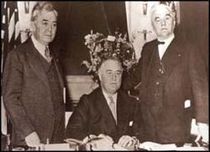 Franklin Delano Roosevelt (center) signs the Rural Electrification Act with Representative John Rankin (left) and Senator George Norris (right)
Franklin Delano Roosevelt (center) signs the Rural Electrification Act with Representative John Rankin (left) and Senator George Norris (right)
Rural Electrification Act
Wikipedia
The Rural Electrification Act of 1936, enacted on May 20, 1936, provided federal loans for the installation of electrical distribution systems to serve isolated rural areas of the United States.
The funding was channeled through cooperative electric power companies, most of which still exist today. These member-owned cooperatives purchased power on a wholesale basis and distributed it using their own network of transmission and distribution lines. The Rural Electrification Act was also an attempt made by FDR's New Deal to deal with high unemployment.
Power and the Land
Published on Jun 13, 2013
The Rural Electrification Administration (REA) commissioned "Power and the Land" in 1940 to show farmers how electricity could improve their lives. The 38-minute movie chronicles two dawn-to-dusk days on the Parkinsons' dairy farm: one day before the lights came on and one day after.
"Power and the Land" premiered at the Old Trail Theater in St. Clairsville, Ohio, on August 31, 1940. After being picked up by RKO Radio Pictures a few months later, it was distributed to 5,000 movie theaters across the country.
Rural Utilities Service (RUS) - U.S. Dept. Agriculture
Rural Utilities Service
Wikipedia
The United States Rural Utilities Service (RUS) administers programs that provide infrastructure or infrastructure improvements to rural communities. These include water and waste treatment, electric power, and telecommunications services.[1] it is an operating unit of the USDA Rural Development agency of the United States Department of Agriculture (USDA).
The RUS assists rural electric and telecommunications utilities in obtaining financing and administers a nationwide water and waste loan and grant program. A total of 890 rural electric and 800 rural telecommunications utilities in 47 States, Puerto Rico, the Virgin Islands, Guam, the Marshall Islands, the Northern Mariana Islands, and the Federated States of Micronesia have received financial assistance. Approximately 7,200 rural communities are served through financial assistance received from water and waste loans and grants.[2]
The RUS runs the following programs:
Water and Environmental: provides financial assistance for drinking water, sanitary sewer, solid waste and storm drainage facilities in rural areas and communities with a population of 10,000 or less.[1]
Electric Programs: help maintain, expand, upgrade and modernize the rural electric infrastructure. It also supports demand-side management, energy efficiency and conservation programs, and on-and off-grid renewable energy systems.[1]
Telecommunications: helps deploy the rural telecommunications infrastructure.[1]
History
RUS originated with the Rural Electrification Administration (REA), one of the agencies created under in 1935 to promote rural electrification. In the 1930s, the U.S. lagged behind Europe in providing electricity to rural areas. In 1934, less than 11% of US farms had electricity. That same year, in France and Germany, nearly 90% of farms had electricity.
Backed by the 1936 Rural Electrification Act the REA gave loans and other help to rural organizations setting up their own power systems and was one of the New Deal's most successful programs.[3] By 1937, hundreds of new municipal power utilities were created nationwide. In 1939, 288,000 households had their electricity provided by rural electric cooperatives; most of these electric coops had applied for and received loans from REA. By 1942, nearly 50% of US farms had electricity, and by 1952 almost all US farms had electricity.[4]
In 1949, the REA became authorized to provide loans to rural telephone cooperatives.[5]
Under the Department of Agriculture Reorganization Act of 1994 the REA became the RUS. Read more




